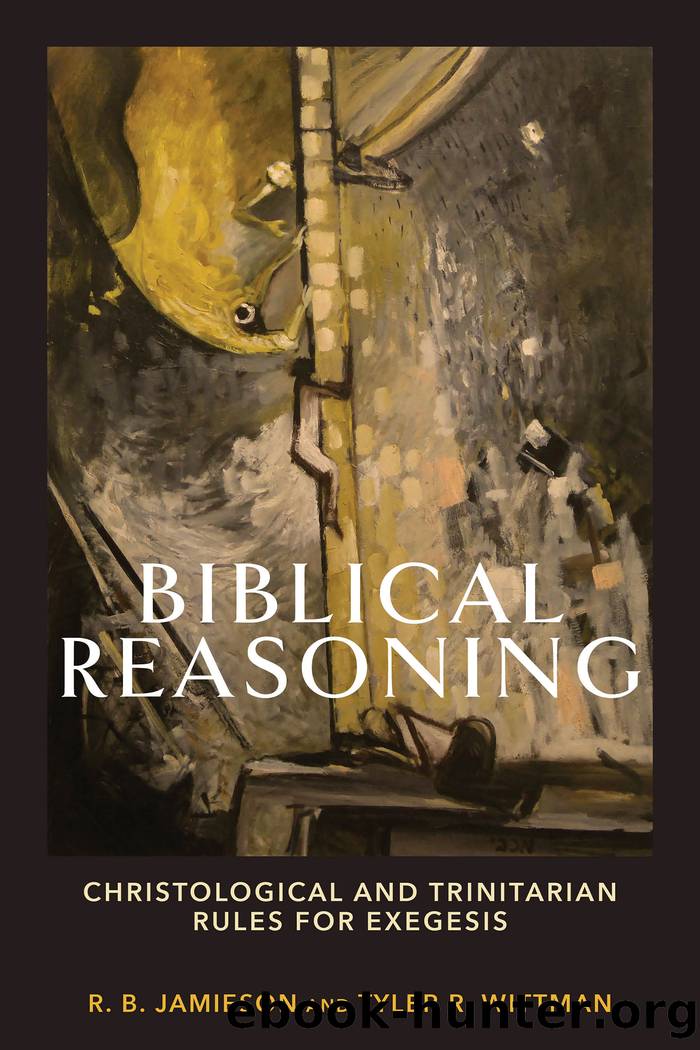Biblical Reasoning by R. B. Jamieson

Author:R. B. Jamieson
Language: eng
Format: epub
Tags: Theology/Biblical Interpretation;Bible—Criticism | interpretation | etc;Bible—Theology;Jesus Christ—Person and offices;Trinity;REL006400;REL067000
Publisher: Baker Publishing Group
Published: 2022-04-25T00:00:00+00:00
The Grammar of Christological Paradoxes: The Hypostatic Union
Given the pressures discerned and described above, in this section we must now process these pressures in order to discern their underlying grammar, asking how it is that these various pressures presuppose and display a deeper framework of coherence. In other words, why does Scripture speak about Jesus in these ways? What is the reality that demands to be spoken of in such paradoxical patterns?
Preserving Paradox
As we move from Scriptureâs pressures about Jesus to its underlying grammar, we must state at the outset that the truth these passages teach is irreducibly mysterious. According to Francis Turretin, the most difficult questions in theology are the unity of three persons in one being and âthe union of the two natures in the one person in the incarnation.â25 So when discussing the hypostatic union, we are not solving but stating the mystery.
Therefore, we are not setting aside paradox, but vindicating it as paradox and not contradiction. By âparadoxâ here we mean an apparent contradiction that ultimately is consistent. For Jesus to be both God and man seems contradictory but ultimately is not. Paradox is thus intrinsic to the confession that âJesus is Lordâ (1 Cor. 12:3), and biblical reasoning must preserve this paradox, owning that seemingly contradictory characteristics coalesce in Christ.26 For this reason, the incarnation is a mystery, something we cannot fully explain. Given the reality of the Word made flesh, we should not shrink from paradox but instead revel in it. Orthodoxy is not about explaining mystery away but maintaining it. Orthodoxy stands upright not because it discards the weight of inconvenient evidence but because it keeps seemingly opposing truths in exact equipoise. So what does Scriptureâs pressure presuppose about the union in Christ of divinity and humanity?
The Hypostatic Union
In light of the foregoing, the biblical discourse about the unity of Christ and the diversity of predicates befitting him are reconciled in the underlying grammar of what theologians traditionally call the hypostatic union. This doctrine is clearly articulated by the Chalcedonian creed, which our sixth principle echoes: âOne and the same Lord Jesus Christ, the only begotten Son, must be acknowledged in two natures, without confusion or change, without division or separation. The distinction between the natures was never abolished by their union, but rather the character [ἰδιÏÏηÏοÏ, idiÅtÄtos] proper to each of the two natures was preserved as they came together in one Person and one hypostasis.â27
Notice first of all that this tells us nothing about how the hypostatic union occurs, but only that the union occurs in Christâs one person. The Son of God assumed a human nature into union with his person, such that God the Son now truly exists as a man. This remains a mystery because this personal union is not âsuch as could be found in the sphere of created nature at all, but is an absolutely unique, supereminent union.â28 Therefore, we can know more about what this union is not than about what it is. This is not a union in nature, where divinity and humanity become some third thing.
Download
This site does not store any files on its server. We only index and link to content provided by other sites. Please contact the content providers to delete copyright contents if any and email us, we'll remove relevant links or contents immediately.
| Exegesis & Hermeneutics | New Testament |
| Old Testament |
The Five People You Meet in Heaven by Mitch Albom(3474)
The Secret Power of Speaking God's Word by Joyce Meyer(2970)
Real Sex by Lauren F. Winner(2967)
Name Book, The: Over 10,000 Names--Their Meanings, Origins, and Spiritual Significance by Astoria Dorothy(2939)
The Holy Spirit by Billy Graham(2892)
0041152001443424520 .pdf by Unknown(2784)
ESV Study Bible by Crossway(2732)
How The Mind Works by Steven Pinker(2729)
Ancient Worlds by Michael Scott(2622)
Churchill by Paul Johnson(2506)
The Meaning of the Library by unknow(2505)
The ESV Study Bible by Crossway Bibles(2502)
The Gnostic Gospels by Pagels Elaine(2470)
MOSES THE EGYPTIAN by Jan Assmann(2372)
Jesus by Paul Johnson(2310)
City of Stairs by Robert Jackson Bennett(2307)
The Complete Dead Sea Scrolls in English (7th Edition) (Penguin Classics) by Geza Vermes(2234)
Ancient Near Eastern Thought and the Old Testament by John H. Walton(2196)
The Nativity by Geza Vermes(2180)
